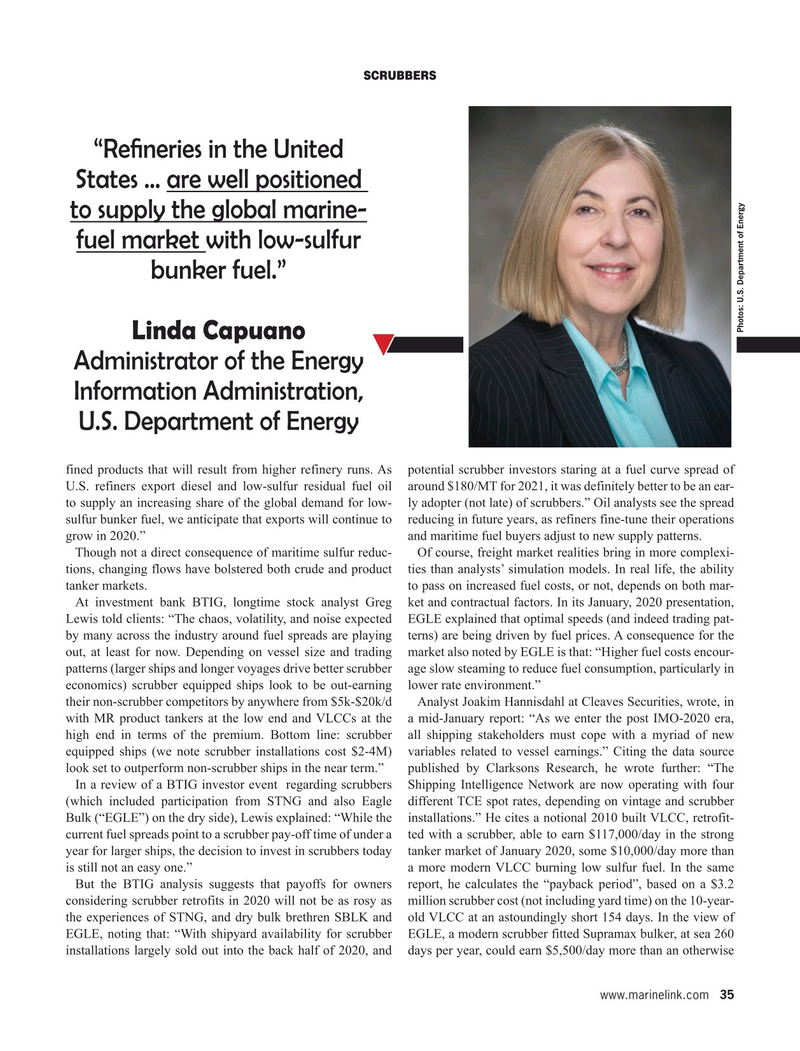
Page 35: of Maritime Reporter Magazine (February 2020)
Green Ship Technology
Read this page in Pdf, Flash or Html5 edition of February 2020 Maritime Reporter Magazine
SCRUBBERS “Re? neries in the United
States ... are well positioned to supply the global marine- fuel market with low-sulfur bunker fuel.”
Photos: U.S. Department of Energy
Linda Capuano
Administrator of the Energy
Information Administration,
U.S. Department of Energy fined products that will result from higher refinery runs. As potential scrubber investors staring at a fuel curve spread of
U.S. refiners export diesel and low-sulfur residual fuel oil around $180/MT for 2021, it was definitely better to be an ear- to supply an increasing share of the global demand for low- ly adopter (not late) of scrubbers.” Oil analysts see the spread sulfur bunker fuel, we anticipate that exports will continue to reducing in future years, as refiners fine-tune their operations grow in 2020.” and maritime fuel buyers adjust to new supply patterns.
Though not a direct consequence of maritime sulfur reduc- Of course, freight market realities bring in more complexi- tions, changing flows have bolstered both crude and product ties than analysts’ simulation models. In real life, the ability tanker markets. to pass on increased fuel costs, or not, depends on both mar-
At investment bank BTIG, longtime stock analyst Greg ket and contractual factors. In its January, 2020 presentation,
Lewis told clients: “The chaos, volatility, and noise expected EGLE explained that optimal speeds (and indeed trading pat- by many across the industry around fuel spreads are playing terns) are being driven by fuel prices. A consequence for the out, at least for now. Depending on vessel size and trading market also noted by EGLE is that: “Higher fuel costs encour- patterns (larger ships and longer voyages drive better scrubber age slow steaming to reduce fuel consumption, particularly in economics) scrubber equipped ships look to be out-earning lower rate environment.” their non-scrubber competitors by anywhere from $5k-$20k/d Analyst Joakim Hannisdahl at Cleaves Securities, wrote, in with MR product tankers at the low end and VLCCs at the a mid-January report: “As we enter the post IMO-2020 era, high end in terms of the premium. Bottom line: scrubber all shipping stakeholders must cope with a myriad of new equipped ships (we note scrubber installations cost $2-4M) variables related to vessel earnings.” Citing the data source look set to outperform non-scrubber ships in the near term.” published by Clarksons Research, he wrote further: “The
In a review of a BTIG investor event regarding scrubbers Shipping Intelligence Network are now operating with four (which included participation from STNG and also Eagle different TCE spot rates, depending on vintage and scrubber
Bulk (“EGLE”) on the dry side), Lewis explained: “While the installations.” He cites a notional 2010 built VLCC, retrofit- current fuel spreads point to a scrubber pay-off time of under a ted with a scrubber, able to earn $117,000/day in the strong year for larger ships, the decision to invest in scrubbers today tanker market of January 2020, some $10,000/day more than is still not an easy one.” a more modern VLCC burning low sulfur fuel. In the same
But the BTIG analysis suggests that payoffs for owners report, he calculates the “payback period”, based on a $3.2 considering scrubber retrofits in 2020 will not be as rosy as million scrubber cost (not including yard time) on the 10-year- the experiences of STNG, and dry bulk brethren SBLK and old VLCC at an astoundingly short 154 days. In the view of
EGLE, noting that: “With shipyard availability for scrubber EGLE, a modern scrubber fitted Supramax bulker, at sea 260 installations largely sold out into the back half of 2020, and days per year, could earn $5,500/day more than an otherwise www.marinelink.com 35
MR #2 (34-49).indd 35 2/5/2020 11:29:24 AM

 34
34

 36
36
